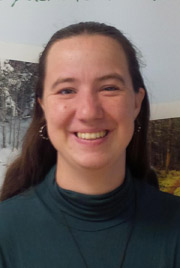Stories from the forest floor
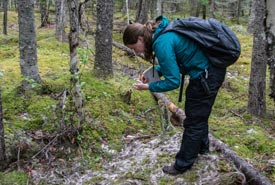
Joanna Hudgins, NCC summer intern, cheerfully collecting bones (Photo by Claire Elliott/NCC staff)
As a child, I was dogged by an unfortunate desire to pick up all kinds of things in the woods that were deemed inappropriate by adults. I never did understand what was dirty about a bone or a feather. They were fascinating, especially if you could figure out who or what they came from.
As I grew up, I learned to curb my scavenging tendencies around most people, since it got tiresome to hear, "Ew, gross, you’re touching that?" every time I stopped to investigate something dead.
I was a very well-adjusted, well-behaved adult... Until I tossed it all away and went back to school to become a fish and wildlife technician. School led me to an internship with the Nature Conservancy of Canada and an opportunity to explore New Brunswick and Prince Edward Island in a way I’d never seen them before.
A large part of my job this summer is monitoring NCC’s properties in New Brunswick with my fellow intern, Claire. To that end, Claire and I found ourselves walking through a very wet forest in early June, hoping to hear olive-sided flycatchers.
On a stop to photograph a patch of painted trilliums, my eye landed on a mess of fur scattered through the flowers. All thoughts of pictures went out the window. This was much more interesting! This was like Christmas!
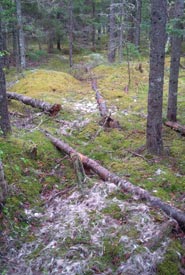
Remains of a white-tailed deer in the Chignecto Isthmus, NB (Photo by Claire Elliot/NCC staff)
I had stumbled on all that was left of a white-tailed deer. It had likely died in the winter — quite possibly from starvation, considering the previous harsh winter. Once the snow had thawed, it had been discovered by local predators.
Completely engrossed, I eagerly began to rummage through the pile. To some, it might just have looked like a lot of hair, but to me it was a mystery and a story all in one. You can learn so much from animal remains: what predators might be in the area, who has visited the site since or sometimes how the animal died or how old it was. This site was no exception.
Digging through the scattered fur, I discovered scat that looked like a dog’s, but which contained bone chips and deer hair: coyote. That wasn’t much of a surprise, but in the middle of the fur I found scat that was almost entirely composed of hair but was much bigger than the coyote scat: black bear.
Black bears do love venison, but they tend to like their venison young and spotted. They’ll hunt fawns in the spring, but often their first food of the year is vegetation, and their scat can resemble a greenish-black plop. This bear got lucky and found a major source of protein, maybe soon after emerging from a very long nap (just think of it as stumbling over a tray of fresh waffles, bacon and fresh fruit entirely by accident after sleeping soundly for five months.)
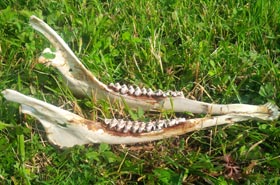
White-tailed deer jawbone (Photo by Claire Elliott/NCC staff)
Scattered among the hair were bones and bone fragments. I found partial ribs, a cracked humerus and unidentifiable fragments, all with the marrow cleaned out. I was collecting them with the same enthusiasm as a child has on a treasure hunt, when I was startled out of my cheerful reverie by my amused co-worker, who was taking pictures of me.
I hazily remembered that I was supposed to be doing a bird survey, but then I found the biggest prize of all: an intact jawbone. Jawbones offer something unique among the bones: the ability to guess an animal’s age. The schedule of tooth eruption and the wear on the teeth allow the animal to be aged with some degree of accuracy. I had been trained in the technique at school but it’s always more exciting to put new skills to use in the field.
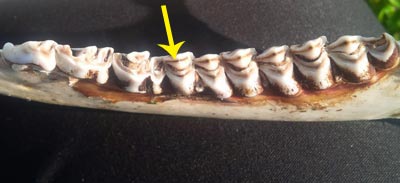
White-tailed deer jawbone, showing dentine that is narrower than the enamel in the first molar (see arrow) (Photo by Claire Elliott/NCC staff)
The jawbone had six premolars and molars, which is the typical complement of an adult white-tailed deer (fawns have four). The third premolar was an adult tooth with two cusps (pointed parts of the tooth) instead of the three-cusped tooth which is present until it is replaced at 18 months of age. The first molar had dentine (the dark strip showing in the interior of the tooth) narrower than the enamel that surrounded it and very little wear, making the deer two and a half years old.
I went home happy, with a mind full of absorbing discoveries. A day in the alder thickets and forests of the Chignecto Isthmus gave us the olive-sided flycatcher we’d been hoping to find as well as the intertwined stories of some of the other forest residents. We know so little of what happens in the forest when we’re not there. An opportunity like the one I was given tells a little more of the tale.

